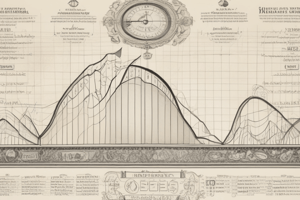Podcast
Questions and Answers
What is the key feature of interval scales that distinguishes them from nominal and ordinal scales?
What is the key feature of interval scales that distinguishes them from nominal and ordinal scales?
- Interval scales represent equal differences in the measured trait.
- Interval scales have an absolute zero point.
- Interval scales can be used to analyze data statistically.
- Interval scales have equal intervals between the numbers. (correct)
Why is an IQ of 0 not possible on most intelligence tests?
Why is an IQ of 0 not possible on most intelligence tests?
- Intelligence tests are not designed to measure a complete absence of intelligence. (correct)
- Intelligence tests are not sensitive enough to measure very low levels of intelligence.
- Intelligence tests are only designed to measure above-average levels of intelligence.
- Intelligence tests are biased against those with very low levels of intelligence.
What is the key assumption made when using interval scales to analyze data?
What is the key assumption made when using interval scales to analyze data?
- The differences between consecutive numbers on the scale are equal.
- The scale has an absolute zero point.
- The scale can be used to make comparisons between individuals.
- All test-takers possess some degree of the trait being measured. (correct)
How are the differences between IQ scores of 80, 100, and 120 interpreted?
How are the differences between IQ scores of 80, 100, and 120 interpreted?
What is an example of an interval scale used to measure the passage of time?
What is an example of an interval scale used to measure the passage of time?
Which of the following is a key property of interval scales that is not present in nominal or ordinal scales?
Which of the following is a key property of interval scales that is not present in nominal or ordinal scales?
What is the primary purpose of measurement in psychological assessment?
What is the primary purpose of measurement in psychological assessment?
What is the key difference between discrete and continuous variables?
What is the key difference between discrete and continuous variables?
What type of variable is used to represent the outcome of a coin toss?
What type of variable is used to represent the outcome of a coin toss?
Which of the following is an example of a polytomous variable?
Which of the following is an example of a polytomous variable?
Which of the following is an example of a continuous variable?
Which of the following is an example of a continuous variable?
What is the key benefit of using measurement in psychological assessment?
What is the key benefit of using measurement in psychological assessment?
What characteristic defines ratio scales of measurement?
What characteristic defines ratio scales of measurement?
In ratio scales, what statement about numbers is true?
In ratio scales, what statement about numbers is true?
Which scenario demonstrates the use of ratio-level measurement?
Which scenario demonstrates the use of ratio-level measurement?
What is an example of a variable measured using ratio-level measurement?
What is an example of a variable measured using ratio-level measurement?
Why is it meaningful to say that a test-taker completing an assembly in 30 seconds has taken half the time of another who completed it in 60 seconds?
Why is it meaningful to say that a test-taker completing an assembly in 30 seconds has taken half the time of another who completed it in 60 seconds?
Which of the following best describes the property achieved by numbers on ratio scales?
Which of the following best describes the property achieved by numbers on ratio scales?
What type of mathematics branch is dedicated to organizing, summarizing, and analyzing numerical data in psychological testing?
What type of mathematics branch is dedicated to organizing, summarizing, and analyzing numerical data in psychological testing?
In the field of statistics, what is the term used for organizing raw data into a more compact form before statistical analysis?
In the field of statistics, what is the term used for organizing raw data into a more compact form before statistical analysis?
Which type of statistics involves using data to estimate population values based on sample values or to test hypotheses?
Which type of statistics involves using data to estimate population values based on sample values or to test hypotheses?
What is the primary purpose of a frequency distribution in statistics?
What is the primary purpose of a frequency distribution in statistics?
What do grouped frequency distributions help achieve when dealing with a large range of scores?
What do grouped frequency distributions help achieve when dealing with a large range of scores?
Why are individual scores not listed separately in grouped frequency distributions?
Why are individual scores not listed separately in grouped frequency distributions?
What is the primary reason why the average deviation is discussed in the text?
What is the primary reason why the average deviation is discussed in the text?
How does the standard deviation deal with the problem of the sum of deviation scores around the mean equaling zero?
How does the standard deviation deal with the problem of the sum of deviation scores around the mean equaling zero?
What is the relationship between the standard deviation and the variance?
What is the relationship between the standard deviation and the variance?
Why does the text mention the deletion of algebraic signs in the context of the average deviation?
Why does the text mention the deletion of algebraic signs in the context of the average deviation?
What is the definition of the standard deviation provided in the text?
What is the definition of the standard deviation provided in the text?




